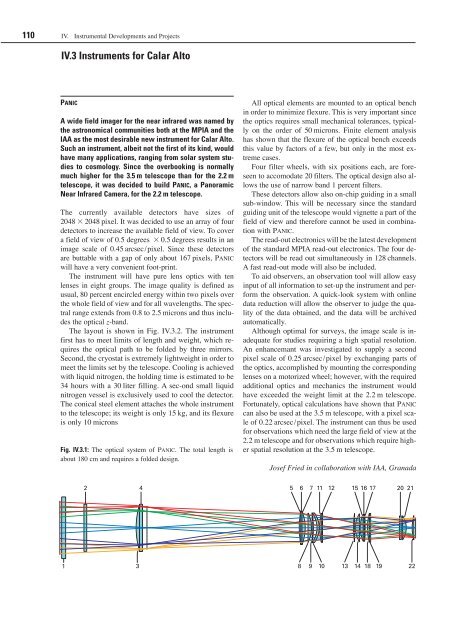Max Planck Institute for Astronomy - Annual Report 2007
Max Planck Institute for Astronomy - Annual Report 2007
Max Planck Institute for Astronomy - Annual Report 2007
You also want an ePaper? Increase the reach of your titles
YUMPU automatically turns print PDFs into web optimized ePapers that Google loves.
110 IV. Instrumental Developments and Projects<br />
IV.3 Instruments <strong>for</strong> Calar Alto<br />
Panic<br />
A wide field imager <strong>for</strong> the near infrared was named by<br />
the astronomical communities both at the MPIA and the<br />
IAA as the most desirable new instrument <strong>for</strong> Calar Alto.<br />
Such an instrument, albeit not the first of its kind, would<br />
have many applications, ranging from solar system studies<br />
to cosmology. Since the overbooking is normally<br />
much higher <strong>for</strong> the 3.5 m telescope than <strong>for</strong> the 2.2 m<br />
telescope, it was decided to build Panic, a Panoramic<br />
Near Infrared Camera, <strong>for</strong> the 2.2 m telescope.<br />
The currently available detectors have sizes of<br />
2048 2048 pixel. It was decided to use an array of four<br />
detectors to increase the available field of view. To cover<br />
a field of view of 0.5 degrees 0.5 degrees results in an<br />
image scale of 0.45 arcsec/pixel. Since these detectors<br />
are buttable with a gap of only about 167 pixels, Panic<br />
will have a very convenient foot-print.<br />
The instrument will have pure lens optics with ten<br />
lenses in eight groups. The image quality is defined as<br />
usual, 80 percent encircled energy within two pixels over<br />
the whole field of view and <strong>for</strong> all wavelengths. The spectral<br />
range extends from 0.8 to 2.5 microns and thus includes<br />
the optical z-band.<br />
The layout is shown in Fig. IV.3.2. The instrument<br />
first has to meet limits of length and weight, which requires<br />
the optical path to be folded by three mirrors.<br />
Second, the cryostat is extremely lightweight in order to<br />
meet the limits set by the telescope. Cooling is achieved<br />
with liquid nitrogen, the holding time is estimated to be<br />
34 hours with a 30 liter filling. A sec-ond small liquid<br />
nitrogen vessel is exclusively used to cool the detector.<br />
The conical steel element attaches the whole instrument<br />
to the telescope; its weight is only 15 kg, and its flexure<br />
is only 10 microns<br />
Fig. IV.3.1: The optical system of Panic. The total length is<br />
about 180 cm and requires a folded design.<br />
1<br />
2<br />
3<br />
4<br />
All optical elements are mounted to an optical bench<br />
in order to minimize flexure. This is very important since<br />
the optics requires small mechanical tolerances, typically<br />
on the order of 50 microns. Finite element analysis<br />
has shown that the flexure of the optical bench exceeds<br />
this value by factors of a few, but only in the most extreme<br />
cases.<br />
Four filter wheels, with six positions each, are <strong>for</strong>eseen<br />
to accomodate 20 filters. The optical design also allows<br />
the use of narrow band 1 percent filters.<br />
These detectors allow also on-chip guiding in a small<br />
sub-window. This will be necessary since the standard<br />
guiding unit of the telescope would vignette a part of the<br />
field of view and there<strong>for</strong>e cannot be used in combination<br />
with Panic.<br />
The read-out electronics will be the latest development<br />
of the standard MPIA read-out electronics. The four detectors<br />
will be read out simultaneously in 128 channels.<br />
A fast read-out mode will also be included.<br />
To aid observers, an observation tool will allow easy<br />
input of all in<strong>for</strong>mation to set-up the instrument and per<strong>for</strong>m<br />
the observation. A quick-look system with online<br />
data reduction will allow the observer to judge the quality<br />
of the data obtained, and the data will be archived<br />
automatically.<br />
Although optimal <strong>for</strong> surveys, the image scale is inadequate<br />
<strong>for</strong> studies requiring a high spatial resolution.<br />
An enhancemant was investigated to supply a second<br />
pixel scale of 0.25 arcsec/pixel by exchanging parts of<br />
the optics, accomplished by mounting the corresponding<br />
lenses on a motorized wheel; however, with the required<br />
additional optics and mechanics the instrument would<br />
have exceeded the weight limit at the 2.2 m telescope.<br />
Fortunately, optical calculations have shown that Panic<br />
can also be used at the 3.5 m telescope, with a pixel scale<br />
of 0.22 arcsec/pixel. The instrument can thus be used<br />
<strong>for</strong> observations which need the large field of view at the<br />
2.2 m telescope and <strong>for</strong> observations which require higher<br />
spatial resolution at the 3.5 m telescope.<br />
Josef Fried in collaboration with IAA, Granada<br />
5 6 7 11 12 15 16 17 20 21<br />
8 9 10 13 14 18 19<br />
22

















